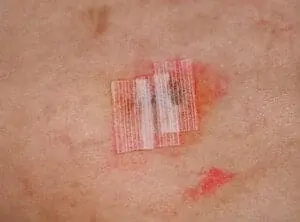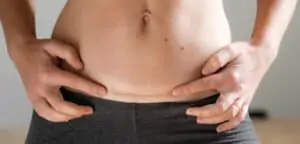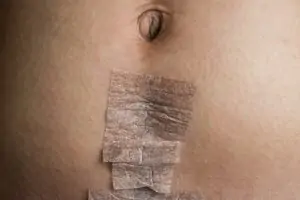Let’s be honest with you:
Healing from a c-section doesn’t stop when you leave the hospital. You have many weeks of recovery ahead because you have internal stitches after a c-section that needs to dissolve along with your external incision.
It’s easy to forget about your internal wound when all you can see is the exterior. A week after your surgery, your external incision will be closed and look better, but you have a large internal incision plus a wound where your placenta is attached inside your uterus that needs to heal.
Sound painful?
Let’s be real; a c-section is a SERIOUS surgery, and the recovery is sometimes tough. You need to understand your surgery and what happened to your body to heal properly.
So, let’s take a look at how your doctor closed your incision and what you need to know about each method, along with possible warning signs of problems.
The Different Types of C-Section Closures
Each surgeon has a different method to close a c-section incision. Staples are the traditional method, but stitches and glue are becoming more popular.
Statistically, no one closure method is better than the other. All are efficient ways to close an incision and have the same results as the other. Some doctors just prefer a different closure over the others.
Remember that you can speak to your doctor and let him know your closure preferences. Most doctors will follow your lead if you prefer one over the other.
Let’s take a look at three of the most common closures.

Glue
When I had my first c-section, the OBGYN used glue, and I had to admit – I was a bit confused. Was super glue holding me together? 😮
No, it’s not super glue, but glue is a popular choice because you don’t need to have it removed, and it doesn’t pull or yank. The adhesive is called Dermabond, and the evidence does show that it’s a safe alternative to staples.
Sometimes, your doctor might add steri-strips over the top as well. It’s a clean, reliable way to close a c-section, and many doctors pick glue.
Stitches
Stitches are a simple choice. Your doctor may or may not use dissolvable stitches on the exterior. If they aren’t dissolvable, your doctor will need to remove the stitches at your one-week postpartum exam.
One study indicated that women with dissolvable stitches have a 57% decreased risk of wound complications over women with staples. Studies show that, while sutures do take considerably longer to use in the operating room, they reduce the risk of infection.
Staples
For two of my four c-sections, my wound was closed with staples. While they do have some frustrating parts, I found that I prefer my scars after staples. I felt as if my scar looks neater and straighter.
Staples are placed on your external incision to keep everything neat and closed. Some doctors remove staples as soon as three days postpartum, but in my experience, all of my staples were removed at one week postpartum.
Don’t be worried about the staple removal. Each staple only takes a few seconds, and it feels like a small pinch. That’s it!
We’ve gathered some DOs and DON’Ts for faster c-section healing here, you can read them.
How Many Layers Are Stitched During The C-Section?
Believe it or not, when you have a c-section, the doctor has to cut through seven layers of tissue. So, if you’re wondering why you’re so sore, think about that!
The seven layers are:
- Skin
- Fat
- Rectus Sheath
- Rectus
- Parietal Peritoneum
- Loose Peritoneum
- Uterus
That’s a lot of tissue, and some of those layers are tough muscular layers. The tissue in and around your incision aggressively heals for around three months, but that healing process continues for six months or longer. That’s one of the primary reasons you need to rest a lot!
Even though your doctor cut through seven layers to reach your baby, your OBGYN doesn’t stitch seven layers closed during a c-section. Typically, a doctor stitches two layers. You’ll have internal stitches for the inside layers and an external layer.
How Long Does It Take for Internal Stitches to Heal After a C-Section?
Your internal stitches start to dissolve a few days after you give birth. By the time you’re two weeks postpartum, the internal incision is fully closed, but that doesn’t mean you are fully healed.
Surgeons use absorbable sutures, which are made of unique materials that remain in your body for a period. Your doctor dissolves the sutures well after the incision is closed. You don’t have to worry about the c-section stitches coming out before the incision itself is shut. It does take time to dissolve!
Cautions:
Don’t take that as a time to start going on hikes or vigorous bicycle riding or driving a car. Even though the incision is closed, it doesn’t mean your body is healed and recovered.
It takes three-six months for your internal incision to fully heal. The good thing is that if you’re worried that you can tear internal c-section stitches after a year, you now know that you can’t! Your incision is fully healed after a year.
How Long Do Steri-Strips Need to Stay on After a C-Section?
Steri-strips are like duct tape for surgery; they don’t come off quickly. After my last c-section, my nurse had to remove one of the strips because I was bleeding, and it felt like she would also remove my skin.

Ouch! 🙁
Typically, steri-strips should be removed one week after your surgery, but they might fall off beforehand. Be sure not to cover them during showers; the moisture will help the strips come off on their own.
If the strips don’t come off by themselves after a week, you can remove them yourself ten days after your surgery. Don’t forcibly remove them beforehand. You should spend with your caregiver; some want you to come into their offices to have strips removed.
How to Prevent Problems With Your Incision?
In general, c-sections are generally considered a safe procedure, but you must remember that it’s major surgery. You must take proper care of your incision to prevent any problems with your incision.
Here are some suggestions to help keep your incision infection and injury-free.
Keep It Clean
You must keep the area clean even though you’ll be sore for quite a while. When you’re showering, it’s safe to let water and soap run down the incision, or you can gently wash the incision with a washcloth.
Make sure you DON’T scrub the incision. Just pat it dry with a towel.
Check Your Incision Daily
Make sure that you inspect your incision each day, which will help you notice if any issues develop. That allows you to catch the problems before they become too severe. You’ll be able to see if the incision looks red or angry instead of getting better or if there is sudden drainage that looks a bit worrisome.
Don’t Exercise
Now is not the time to exercise. Too much activity can cause your internal stitches and external closures to break open. Be careful when bending over or lifting heavy objects.
Brace Yourself
To avoid breaking open incisions, brace your wounds to prevent the incisions from opening after the surgery. You’ll need or want to brace your c-section when coughing, sneezing, standing up from a seated position, or even when you have a bowel movement.
Wear Loose-Fitting Clothes
Chances are you won’t wait to wear tight-fitting clothes right after your surgery, but if you feel tempted, stay away from the. Tight clothes can irritate your incision, so opt for pajamas, leggings, jogging pants, and baggy shirts for now.
Another benefit of wearing loose clothes is that they help expose your incision to more airflow. Air speeds the healing process.
Take Your Pain Relievers

Your doctor will prescribe pain relievers, which you must take to ease discomfort. You might take ibuprofen, acetaminophen, or prescription pain relievers. Be sure to stay on top of your pain; if you let the pain get too much, it’ll make it harder to go away.
Apply Heat to Your Abdomen
Your incision will be sore for a week or two, and heat can help reduce pain and soreness. Try using a heating pad on your abdomen for 15 minutes at a time.
How Do I Know If My C-Section is Healing Inside?
You cannot see inside your incision, but there are ways to tell if it’s healing properly. It takes up to six-eight weeks for your body to heal, so give it the time it needs.
Here are signs that your internal stitches are healing.
- Decreased pain
- Reduced swelling or redness
- Easier to move with less discomfort
- Easier to complete daily tasks
Can You Feel Internal Stitches After a C-Section?
No, you cannot feel internal stitches after a c-section. The discomfort from the external and internal stitches blend together; it’s impossible to tell the difference.
Internal stitches dissolve fast and heal faster than your external stitches. The typical c-section internal stitches healing time is one week. At that point, your c-section stitches inside are healing and slowly breaking down into your body.
The risk of opening the stitches at this point is quite low.
Can Internal Stitches Open After a C-Section?
Yes, c-section stitches inside can open, but it’s not as common as external stitches opening. Ripping internal stitches after a c-section takes effort. In most cases, it’s because a mother exercised too early, lifted too much, or strained too much during physical activity.
Infection often delays the c-section stitch’s dissolution time. Most stitches should be fully dissolved by two weeks, but if you develop a uterine infection or your incision is infected, it delays the healing process. That increases the risk of your c-section stitches opening.
Having a vertical c-section increases the risk of ripping your internal stitches after a c-section. In general, vertical cuts don’t heal as well and take longer to heal than horizontal cuts.
How to Tell If You Ripped Internal Stitches After a C-Section?
In the ideal world, your surgical wounds will heal and close properly, with the edges staying intact while the new tissue forms. However, a common surgical complication is when the surgical incision breaks apart. When a wound opens, it’s called wound dehiscence, which happens in 6-7% of c-sections.
Worrying about popped internal stitches after a c-section is normal! The last thing you want is to need to go back into the hospital after finally making it home with your baby.
You must avoid straining, lifting a toddler, or doing anything that increases pressure on your wounds. Make sure you know the c-section internal stitches rupture symptoms.
Here are some symptoms of torn internal stitches.
- Bleeding from the wound or at entry points
- Heavy vaginal bleeding
- A fever develops over 100.4℉
- Inflammation near and around the surgical area
- Extreme pain at the wound site that is sensitive to touch
- Sudden swelling
- Wound draining that is pus-filled or frothy
- Sudden breaking open of the wound
- Severe internal pain after a c-section
- Dizziness
Signs of an Infection After a C-Section
Moms need to be vigilant about infections after a c-section. 6 to 11% of c-sections end in an infection, and you can end up with an infection in your uterus, belly, or incision. All it takes is bacteria entering your incision, and you end up with an infection.
Here’s how you might know that you have an infected c-section incision.
- Redness (angry red) around your incision that wasn’t there beforehand.
- New swelling around the incision that seems abnormal.
- You find fluid leaking from the wound.
Determining if you have an internal or uterus infection can be a bit more complicated. Here are some sins of a problem.
- You develop a fever.
- There is increasing abdominal pain
- You have foul-smelling vaginal discharge.
What Happens if Stitches Break Open?
Contact your doctor immediately if you have any suspicions that your stitches broke open. Several times, I had sudden pains and worried that something had happened internally. It is difficult to break open internal stitches but not as hard to break open external ones.
If you do happen to break open an internal closure, don’t freak out. It doesn’t mean you’ll automatically undergo surgery again; your doctor is trained to handle these problems.
Note that…
Most doctors will prescribe antibiotics if you break open a suture. You do not want an infection to develop at the wound site, and you might also get additional pain medication. You might end up having a drain placed in your external incision to help any fluid escape.
Expect to visit the doctor multiple times to be checked out. They have to catch any problems as fast as possible. If it’s not getting any better, your doctor will have to go back in and surgically fix the problem.
When to Call 911 or the Doctor

In most cases, you can call your doctor’s office and tell them what is happening. They’ll let you know when to come into the office, but most will schedule you that day. If a small part of your external incision spreads apart, cover it with a clean, dry bandage, and let your doctor know the situation.
Some situations warrant a visit to the emergency room or a call to 911. Here is when you need to seek immediate help.
- If your incision opens wide, cover it and either go to the emergency room or call 911.
- If you start to bleed profusely, head to the emergency room.
- In the event of your wound opening so wide that you can see internal organs or tissues, cover the area with a moist sterile bandage and call 911. Then lie down and elevate your legs.
Taking Care of Your Internal Stitches
If you follow your doctor’s instructions and take care of your incision, your internal stitches will be fine after your c-section. Avoid lifting and putting too much pressure on your abdomen for the first two to three weeks. All it takes is some TLC, and your body will heal quickly.
Hey, this is Linda. My biggest accomplishment in life is being a mother of four children. Their current ages range from almost ten years old down to 20 months old.
I’m passionate about writing parenting articles because I understand so well all of the problems and trials you face as a parent. From breastfeeding woes to budgeting problems and behavior problems, along with everything in between, chances are I’ve faced it over the last ten years. Read more about Linda here.







Thank so much for writing this, I had a c sec on 24/07/20 and I’ve been feeling every now and then a sharp punch like pain and been worried that I’ve opened something. So this article has really helped.
You’re welcome, Michaela. Glad that it helped! 🙂
I had constipation and had to strain now I am worried about my internal stitches please guide
Hi Hannah, I’d make sure you’re drinking plenty of water and check to see if what comes out looks normal. As always, if you’re in any pain, have a fever, or are simply concerned, contact your doctor to get checked out and get peace of mind.
This article was extremely helpful. I always wondered what it was exactly that required stitches and how many layers were cut into. However, I do have a concern. I am 3 1/2 weeks postpartum and I had noticed around my incision , a white piece of what looked like plastics sticking out of my incision . I tried to pick it off with tweezers. I pulled out a decent size white string and ended up just cutting it off and not pull the whole thing out. I am assuming it’s an internal stick that did not dissolve. I’m just hoping I didn’t open my internal incision.
Jade, it sounds like an internal stitch, so I would advise you not to pull on it. Chances are you won’t open your stitches because it’s been 3.5 weeks, but who wants to risk it? Give your doctor a call; they’ll probably want to take a look and snip it for you. They might apply an additional steri-strip over the top for extra measure. Good luck!
I’m concerned I’m 3 weeks post partum my sterile strips still haven’t come off some of them have on the edges but the rest is still really stuck
Hey Victoria, please make sure you’re getting them wet and gently running a washcloth over them each day. That should help. By 3 weeks, your steri strips should have come off. I would call your doctor. Don’t try to remove them yourself. Your doctor will probably have you stop by for a quick visit to remove them for you.
It’s my first c section and am really scared I am 4 weeks already with the c section and I still feel pain is that normal and I been discharged a brownish with a bad smell order and my urine is cloudy is that normal
Hey Elizabeth, here is my take on that – Having discomfort and discharge is normal at 3 weeks postpartum, but a bad smell and cloudy urine indicates an infection. You should speak to your doctor; infections can be treated with antibiotics.
Hi Linda, this article is really helpful. I have birth via C-section for my two beautiful daughters. the first one is last feb.2020 and the second one is last march 2021. Im 10monts post partum now, bit last Saturday, I felt extreme pain on half (right part) of my internal cs wound, I felt like a thunder bolt and stretching and it’s extremely painful after I wrongfully moved from the bed to get my toddler and twisted my abdomen. I rest a bit and after that, the pain is gone. Now, I felt half of my cs wound (left side) after I sneezed roughly giving it an intense pain.. And I can’t cough really well coz I can feel the pain from the inside. Do you think I broke my internal stitches or am I just overacting? Coz I haven’t felt any pain in a while.. just this. Thanks a lot! ❤️
Hi Anne! Congratulations on your daughters! Pain can come up from c-section incisions even years later. It’s a good idea to call your doctor and schedule something to have things looked at. I don’t think it’s come undone since it’s been a year for you since the surgery, but there may be a possibility of scar tissue interfering with things. Either way, get it checked out, especially since that pain seems to be disrupting your life. I hope you feel better soon!